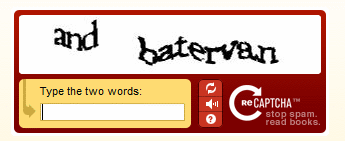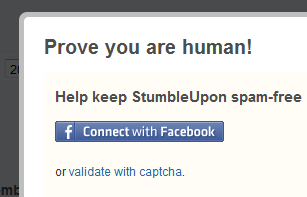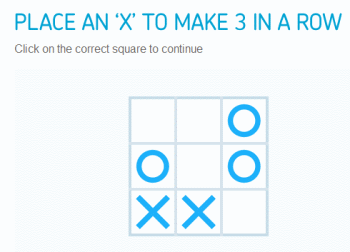Garbled text and kittens: how to prove you're human
Garbled text and kittens: how to prove you're human
Have you heard of a CAPTCHA? Even if you haven't come across the name before, you've still probably used one. CAPTCHAs are those distorted pieces of text you're sometimes asked to type in when you sign up to a website:

CAPTCHAs are meant to be easy for people to solve, but hard for computers to interpret. They help stop automated "bots" from misusing a website's services - for instance, by creating nonsense user accounts or posting spam comments.
The vast majority of CAPTCHAs are like the one shown. They ask you to copy wobbly text into a box. If what you type matches what's shown, you pass and the website assumes you're a real-life person.
There are problems with these CAPTCHAs: even though they're supposed to be easy for humans to understand, in practice they can be devilishly hard to solve. Plenty of sites will attest to that. They also create all sorts of usability problems - and it's not like they're impervious to hackers either.
Given these issues, it's no surprise that some websites are finding more inventive ways of getting people to prove they're human. Some are easy-to-use. Some are probably easy-to-hack. But all offer a break from the traditional text CAPTCHA. Done well, they can even form a part of a website's personality and branding.
Here are four I've come across lately. If you need to make sure real people are signing up to your own website, maybe you could take inspiration from one of them.
1. Choose the matching object
When you sign up to social networking site YUNiTi, you'll be asked to pick three matching 3D images from a selection. This system relies on our ability (and a computer's inability) to recognise the same items from different angles.

2. Connect to Facebook
StumbleUpon is an interesting way to find new, interesting websites. And it gets round the CAPTCHA problem in an unusual way, by requesting access to your Facebook account in order to prove you're real.Have you heard of a CAPTCHA? Even if you haven't come across the name before, you've still probably used one. CAPTCHAs are those distorted pieces of text you're sometimes asked to type in when you sign up to a website:

CAPTCHAs are meant to be easy for people to solve, but hard for computers to interpret. They help stop automated "bots" from misusing a website's services - for instance, by creating nonsense user accounts or posting spam comments.
The vast majority of CAPTCHAs are like the one shown. They ask you to copy wobbly text into a box. If what you type matches what's shown, you pass and the website assumes you're a real-life person. There are problems with these CAPTCHAs: even though they're supposed to be easy for humans to understand, in practice they can be devilishly hard to solve. Plenty of sites will attest to that. They also create all sorts of usability problems - and it's not like they're impervious to hackers either. Given these issues, it's no surprise that some websites are finding more inventive ways of getting people to prove they're human. Some are easy-to-use. Some are probably easy-to-hack. But all offer a break from the traditional text CAPTCHA. Done well, they can even form a part of a website's personality and branding. Here are four I've come across lately. If you need to make sure real people are signing up to your own website, maybe you could take inspiration from one of them. 1. Choose the matching object When you sign up to social networking site YUNiTi, you'll be asked to pick three matching 3D images from a selection. This system relies on our ability (and a computer's inability) to recognise the same items from different angles. 2. Connect to Facebook StumbleUpon is an interesting way to find new, interesting websites. And it gets round the CAPTCHA problem in an unusual way, by requesting access to your Facebook account in order to prove you're real. To be honest, this feels like it's more about getting access to your Facebook account than proving your age. Presumably once you've registered, you can tell all your Facebook friends about StumbleUpon. If you don't feel comfortable with that, or don't have a Facebook account, you can always switch to the standard garbled text method instead. 3. Use pictures of cats Microsoft has created a system called ASIRRA which asks you to identify pictures of cats or dogs from a set of images shown on the screen. Sure, it's cute - but it means clicking several times before you can pass the test. 4. Play noughts and crosses This one's my favourite, and comes courtesy of accounting software site Xero. The inventive screen asks you to finish off a game of noughts and crosses to prove you're human: What do you think of these? Have you found any interesting alternatives to the usual text CAPTCHAs lately? Leave a comment and let us know.


 As the ASSIRA site acknowledges, there's another similar system called KittenAuth which operates in the same way (but doesn't seem to be available at present).
As the ASSIRA site acknowledges, there's another similar system called KittenAuth which operates in the same way (but doesn't seem to be available at present). Clever as this is, I don't imagine it's particularly hacker proof. After all, there are plenty of online noughts and crosses games which understand how to create a row of three. Still, it's undeniably nice, and helps to build an innovative brand image.
Clever as this is, I don't imagine it's particularly hacker proof. After all, there are plenty of online noughts and crosses games which understand how to create a row of three. Still, it's undeniably nice, and helps to build an innovative brand image.





Comments
Add a comment